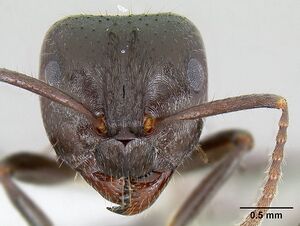Notoncus capitatus
| Notoncus capitatus | |
|---|---|

| |
| Notoncus capitatus | |
| Scientific classification | |
| Kingdom: | Animalia |
| Phylum: | Arthropoda |
| Class: | Insecta |
| Order: | Hymenoptera |
| Family: | Formicidae |
| Subfamily: | Formicinae |
| Tribe: | Melophorini |
| Genus: | Notoncus |
| Species: | N. capitatus |
| Binomial name | |
| Notoncus capitatus Forel, 1915 | |
| Synonyms | |
| |
Identification
- Scutellum in the form of a thick, rounded tumulus or oval process.
- Propodeum distinctly, widely and rather coarsely striate, and largely subopaque throughout; dorsum of gaster generally densely punctulate (weakly so in some individuals) and with dense appressed pubescence; mandibles largely smooth and shining above, with coarse punctures.
- Smaller species, maximum head width less than 1.6 mm; appressed pubescence present on all body tagmata, almost as thick on propodeum as on gaster, with density otherwise diminishing cephalad; head and mesosoma relatively finely sculptured, individual cephalic striae narrower than the diameter of an eye facet; propodeum rounded, not angular.
Keys including this Species
Distribution
Latitudinal Distribution Pattern
Latitudinal Range: -15.75° to -37.07500076°.
| North Temperate |
North Subtropical |
Tropical | South Subtropical |
South Temperate |
- Source: AntMaps
Distribution based on Regional Taxon Lists
Australasian Region: Australia (type locality).
Distribution based on AntMaps
Distribution based on AntWeb specimens
Check data from AntWeb
Countries Occupied
| Number of countries occupied by this species based on AntWiki Regional Taxon Lists. In general, fewer countries occupied indicates a narrower range, while more countries indicates a more widespread species. |

|
Estimated Abundance
| Relative abundance based on number of AntMaps records per species (this species within the purple bar). Fewer records (to the left) indicates a less abundant/encountered species while more records (to the right) indicates more abundant/encountered species. |

|
Biology
Association with Other Organisms
 Explore: Show all Associate data or Search these data. See also a list of all data tables or learn how data is managed.
Explore: Show all Associate data or Search these data. See also a list of all data tables or learn how data is managed.
- This species is a mutualist for the aphid Aphis clerodendri (a trophobiont) (Carver et al., 2003; Saddiqui et al., 2019).
Castes
Images from AntWeb
   
| |
| Worker. Specimen code casent0106015. Photographer Michael Branstetter, uploaded by California Academy of Sciences. | Owned by UCDC, Davis, CA, USA. |
   
| |
| Specimen code CAS0172025-Antwiki.jpg. . | |
     
| |
| Specimen code CAS0172031-Antwiki.jpg. . | |
Nomenclature
The following information is derived from Barry Bolton's Online Catalogue of the Ants of the World.
- capitatus. Notoncus capitatus Forel, 1915b: 90, pl. 1, fig. 8 (w.) AUSTRALIA. Junior synonym of enormis: Brown, 1955d: 489. Revived from synonymy and senior synonym of minor, mjobergi: Taylor, 1992a: 61.
- mjobergi. Notoncus mjobergi Forel, 1915b: 91 (w.) AUSTRALIA. Junior synonym of enormis: Brown, 1955d: 489; of capitatus: Taylor, 1992a: 61.
- minor. Notoncus capitatus var. minor Viehmeyer, 1925b: 139 (w.q.) AUSTRALIA. Junior synonym of enormis: Brown, 1955d: 489; of capitatus: Taylor, 1992a: 61.
Type Material
- Notoncus capitatus: Syntype, 1 worker, Tamborine Mt. [as Mt. Tambourine], Queensland, Australia, Australian National Insect Collection.
- Notoncus capitatus: Syntype, 1 worker, Tamborine Mt. [as Mt. Tambourine], Queensland, Australia, Musee d'Histoire Naturelle Genève.
- Notoncus capitatus: Syntype, worker(s), probably Liverpool or Trial Bay, New South Wales, Australia, Berlin Museum für Naturkunde der Humboldt-Universität.
- Notoncus mjobergi Forel, 1915: Holotype, worker, Colosseum, Queensland, Australia, probably in Naturhistoriska Riksmuseet.
- Notoncus capitatus minor: Syntype, worker(s), probably Liverpool or Trial Bay, New South Wales, Australia, Berlin Museum für Naturkunde der Humboldt-Universität.
Description
References
- Brown, W. L., Jr. (1955). A revision of the Australian ant genus Notoncus Emery, with notes on the other genera of Melophorini. Bulletin of the Museum of Comparative Zoology 113: 471–494.
- Cantone S. 2017. Winged Ants, The Male, Dichotomous key to genera of winged male ants in the World, Behavioral ecology of mating flight (self-published).
- Cantone S. 2018. Winged Ants, The queen. Dichotomous key to genera of winged female ants in the World. The Wings of Ants: morphological and systematic relationships (self-published).
- Forel, A. (1915). Results of Dr. E. Mjöbergs Swedish Scientific Expeditions to Australia 1910-13. 2. Ameisen. Arkiv för Zoologi, 9(16): 1–119.
- Heterick, B.E. 2021. A guide to the ants of Western Australia. Part I: Systematics. Records of the Western Australian Museum, Supplement 86, 1-245 (doi:10.18195/issn.0313-122x.86.2021.001-245).
- Heterick, B.E. 2022. A guide to the ants of Western Australia. Part II: Distribution and biology. Records of the Western Australian Museum, supplement 86: 247-510 (doi:10.18195/issn.0313-122x.86.2022.247-510).
- Siddiqui, J. A., Li, J., Zou, X., Bodlah, I., Huang, X. 2019. Meta-analysis of the global diversity and spatial patterns of aphid-ant mutualistic relationships. Applied Ecology and Environmental Research 17: 5471-5524 (doi:10.15666/aeer/1703_54715524).
- Taylor, R. W. (1992). Nomenclature and distribution of some Australian and New Guinean ants of the subfamily Formicinae. Journal of the Australian Entomological Society 31: 57–69.
- Viehmeyer, H. (1925). Formiciden der australischen Faunenregion. (Schluss.). Entomologische Mitteilungen. Berlin-Dahlem, 14: 139–149.
References based on Global Ant Biodiversity Informatics
- Janda M., G. D. Alpert, M. L. Borowiec, E. P. Economo, P. Klimes, E. Sarnat, and S. O. Shattuck. 2011. Cheklist of ants described and recorded from New Guinea and associated islands. Available on http://www.newguineants.org/. Accessed on 24th Feb. 2011.

